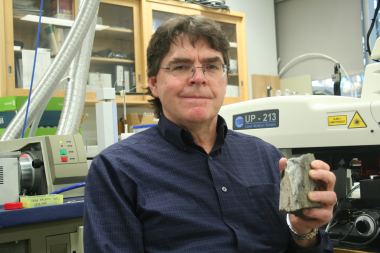A new technique for dating fossils based on uranium's radioactive properties could mean that palaeontologists will have to revise their theories on the end of the dinosaurs.
 |
| Larry Heaman holds the sauropod specimen analysed using the new technique (Image: University of Alberta) |
A Canadian research team has used a new uranium-lead (U-Pb) dating technique to show that a fossilised dinosaur bone found in New Mexico is only 64.8 million years old, meaning the creature was alive about 700,000 years after the mass extinction event that is believed to have wiped out all non-avian dinosaurs.
A team led by Larry Heaman of the University of Alberta's Department of Earth and Atmospheric Sciences used the method to determine the age of the fossilised femur of a sauropod, a herbivorous dinosaur. The in situ U-Pb technique involves laser ablation to remove minute particles of the fossil which then undergo isotopic analysis. The results have now been published in Geology, the journal of the Geological Society of America.
Uranium-235 has a half-life of over 700 million years, while uranium-238 has a half-life of about 4.5 billion years, similar to the age of the Earth itself. These properties mean that the radioactive decay of uranium to lead has previously been used to measure the age of rocks, including those of some of the oldest on Earth, but its use in direct dating of fossils is new. Living bone contains very low levels of uranium. During fossilisation – typically within 1000 years after death – bone becomes enriched in elements including uranium, which decays spontaneously to lead over time. Therefore by measuring the ratio of uranium to lead in a sample its absolute age can be determined.
Currently, palaeontologists date dinosaur fossils by a method called relative chronology, estimating the age of a fossil relative to the known depositional age of the sedimentary rock in which it was found. However, such methods are far from perfect: it is difficult to gain accurate depositional ages for sedimentary rocks, and matters can be further complicated when millions of years of geologic and environmental forces cause erosion of fossil-bearing strata. Fossils can even migrate from their original positions within strata. Heaman and colleagues say their direct dating method can preclude the reworking process that relative chronology entails.
Wrong time?
It is widely believed that all of the non-avian dinosaurs were wiped out in a mass extinction, known as the KT extinction event, that occurred between 65.6 and 66 million years ago in the late Cretaceous period. The results from Heaman's team show that the sauropod in question was alive 64.8 million years ago, 700,000 years after the mass extinction, bringing into question the fate of the dinosaurs after the KT extinction.
There could be several reasons why the New Mexico dinosaur and its ancestors survived the KT extinction. It is widely assumed that the extinction was caused by debris from a giant meteorite which struck Earth, blocking out the sun, causing extreme climate conditions and killing vegetation around the world. Heaman suggests it is possible that vegetation, and hence dinosaurs, survived in some areas. The possibility that dinosaur eggs might survive extreme climatic conditions is also a possible avenue to be explored.
If the new U-Pb dating technique is borne out by more fossil samples, then the KT extinction paradigm and the end of the dinosaurs will have to be revised, Heaman and his colleagues believe.
Researched and written
by World Nuclear News




_18570.jpg)
_16159.jpg)
_18938.jpg)
_33584.jpg)





